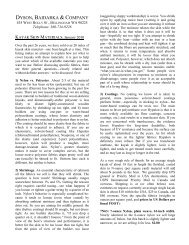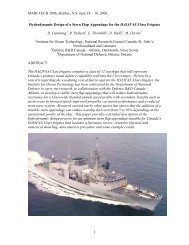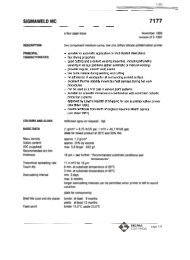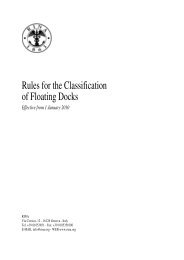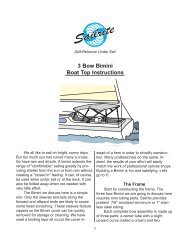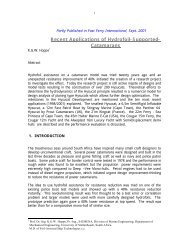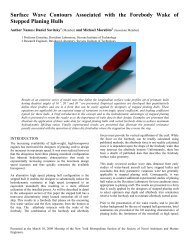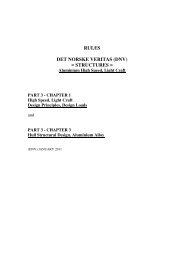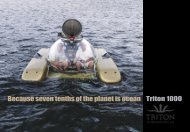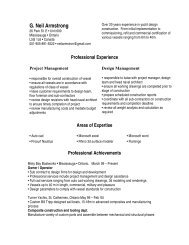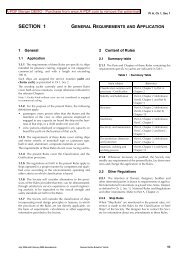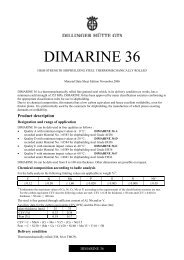CD03 - Issue #74: Designer / Builder Paul Bieker--Process Control ...
CD03 - Issue #74: Designer / Builder Paul Bieker--Process Control ...
CD03 - Issue #74: Designer / Builder Paul Bieker--Process Control ...
Create successful ePaper yourself
Turn your PDF publications into a flip-book with our unique Google optimized e-Paper software.
The Following ArticleIs ProvidedCourtesy of Professional Boatbuilder magazine&Steven CallahanArticles are presented exactly as they first appeared in Professional Boatbuilder© Professional Boatbuilder & Steven Callahan; All Rights ReservedPermissions to reprint or otherwise reuse is required.For permissions, please contact the author; email at:steve@stevencallahan.netOr click on the email address on the bottom of the Home Page.To return to Steven Callahan’s Home Page, click below:http://www.stevencallahan.net/schome.htmlTo return to Steven Callahan’s ProBoat Articles Page,which includes links to a number of articles on leading designers, click:http://www.stevencallahan.net/proboat.htmlTo return to Steven Callahan’s Publications Pagewhich includes links to both articles and books, click:http://www.stevencallahan.net/publications.htmlORYou can go directly to the Articles Page,which links to both the Professional Boatbuilder Articles Pageand other sites containing articles by Steven Callahan,by clicking:http://www.stevencallahan.net/articles.htmlOrYou can go directly to the Books Page,which links to books by Steven Callahan and his associates,plus descriptions and links to books recommended by Steven Callahan,by clicking:http://www.stevencallahan.net/books.html
The magazine for those working in design, construction, and repairNUMBER 74DECEMBER/JANUARY2002$5.95 U.S.DESIGNER/BUILDER PAUL BIEKERPROCESS CONTROLWAVE PIERCERS AND FAST CATSINTEGRAL TANKS
<strong>Bieker</strong>'s BoatsForm flows from function for Seattle-based designer <strong>Paul</strong> <strong>Bieker</strong>.No matter what size the boat. Or boat part.by Steven CallahanI" want to take things to their logicalconclusion, and sometimes that doesn'tlook like what you're used to seeing."<strong>Designer</strong> <strong>Paul</strong> <strong>Bieker</strong>'s statement ideallysuits the International 14 (4.2m) racingdinghy, a venerable one-design developmentclass. Despite its short length, acontemporary International 14 can reachspeeds exceeding 20 knots, by whichtime the boat is little more than a rigjoined to an underwater foil. <strong>Bieker</strong>'sboats currently dominate this still competitivescene. Right now he is workingin Annapolis, Maryland, with Bruce FarrYacht Design on the Oracle-sponsoredAmerica's Cup campaign, where <strong>Bieker</strong>68 PROFESSIONAL BOATBUILDERis very much involved with the engineeringand finite element analysis(FEA) of the new yacht's structure.<strong>Bieker</strong> grew up in Portland, Oregon,sailing big boats. After he graduatedhigh school, his family meanderedthrough the South Pacific for a year anda half on a Swan 48. When others persuadedhim that, as he says, "it wasmore practical to design buildings thanboats," <strong>Bieker</strong> headed for Rhode IslandSchool of Design, but within two yearstraded the practical for the nautical atthe University of California/Berkeley'snaval architecture program.In the mid-1980s, <strong>Bieker</strong> joined thepractice of the late West Coast designerGary Mull, who was using AutoYachtsoftware to draw hulls. At that time,says <strong>Bieker</strong>, "you'd put the printoutunder your vellum and trace it. It wasnot standard practice to draw a boat bycomputer."Soon, however, <strong>Bieker</strong> moved toSeattle to design ships and other largecommercial vessels at Guido Perla andAssociates. Ship-design firms of the daywere working with UNIX-based systemsemploying expensive hardware. By contrast,"for a 240' [73.2m] fishing boat, wewere writing our own CAD [computeraideddesign] programs that ran on PCs
International 14 competition has beenvirtually owned for the past decade byboats designed (and sometimes built)by naval architect <strong>Paul</strong> <strong>Bieker</strong>. His 14sare currently in their third generation,each having numerous iterations. Thesail plan and arrangement for a singleiteration of a second-generation boat(or "<strong>Bieker</strong> 2") appear to the right;<strong>Bieker</strong> 2s were the first 14s to be fittedwith racks, among other innovations.<strong>Paul</strong> <strong>Bieker</strong>, who also races in theseboats, takes them seriously as testplatforms for studying the complexhydro- and aerodynamics of highperformancesail. The 14's compactsize permits subtle, continuousrefinement in hullforms, constructionmaterials and techniques, rigs, andappendages—knowledge that <strong>Bieker</strong>then applies directly to larger designs,such as the 35-footer on the facing page.[personal computers]. We'd design acomplex vessel and get a kit cut out sothat even a small yard could build alarge boat. That sealed my attitudeabout computers," says <strong>Bieker</strong>, who hasalso used ShipCAM but recentlyswitched to Rhinoceros, a modelingprogram not specifically designed forboats but which he finds especiallygood for editing surfaces and dealingwith the reverse curves, knuckles, andfillets found on his designs. [As reportedin an earlier "Rovings" column inProfessional Boat<strong>Builder</strong>, Rhino is availablefrom Robert McNeel & Associates inSeattle—Ed.]For a long time, <strong>Bieker</strong> played withInternational 14s on the side, buildingboats in the evenings, until 1991 when a<strong>Bieker</strong>-designed 14 took the Nationals.With clients lining up for new <strong>Bieker</strong>14s and a boss "who didn't want me tobecome a part-time employee," <strong>Bieker</strong>decided to strike out on his own. He'ssince designed Secondo and third-generationboats—the <strong>Bieker</strong> 2 and <strong>Bieker</strong>3—plus some customized 14s, and hasbuilt close to 40 semi-custom 14s himself.His boats won United States andCanadian championships until 1997,when the Northern Hemisphere,Southern Hemisphere, and Australianfleets amalgamated. <strong>Bieker</strong> recalls thefirst Worlds in San Francisco in 1997:"Charles Stanley chartered my personalboat, put new sails on it, and won. Thatwas pretty neat because there was a lotof talk beforehand that the Aussies weregoing to kick our ass. It didn't turn outthat way." In fact, at the next Worlds inMelbourne, Australia, <strong>Bieker</strong> boatsDECEMBER/JANUARY 2002 69
<strong>Paul</strong> <strong>Bieker</strong> preps his own International 14—a B-3 named Pell Mell—prior to a race.The boat features telescoping racks, a compression vang, and nonferrous rigging.Its deck was made with flat stock, the centerline radius formed with epoxy-filledsaw kerfs on the inside. His shop is called <strong>Bieker</strong> Boats; the design office,Rip Tide Design.swept 1st through 3rd. A year and a halflater they captured eight of the first tenplaces. And in 2001, his boats capturedgold and bronze.Like Bermuda fitted dinghies,International 14s evolved from harbortenders. When 14s became a nationalclass in England in the early 1900s, theyweighed about 250 lbs (113.4 kg). Twocrew hiked out to keep 175 sq ft (16.3sq m) of sail upright. The class wentinternational in the 1920s. Today, 14s flyupwards of 210 sq ft (19.5 sq m) upwindand weigh about 170 lbs (77.1 kg), butthey also fly spinnakers exceeding 500sq ft (46.4 sq m), set on long bowsprits.Their crews develop enormous rightingmoment by hanging on trapezeswhile standing on racks cantilevered offthe boats' sides. Today, a hull mightweigh only 135 lbs (61.2 kg) and themast as little as 15 lbs (6.8 kg). <strong>Bieker</strong>helped propel 14s literally into the jetage thanks to Boeing Corporation'snearby surplus-sales warehouse, whichsupplied him with glass-and-carbonskinnedhoneycomb panels that costless than lumber-yard plywood.Like all designers. <strong>Bieker</strong> says he was"looking for a silver bullet" when hedesigned the <strong>Bieker</strong> 1 comparativelyearly in his career. "My hull shape wasfine-ended with a prismatic coefficient[Cp—the ratio of the boat's volume in itsends to that amidships; a high Cp hasfull ends, a low Cp fine ends] of about0.56 for light-to-moderate air speed. Iwanted straight waterlines forward forupwind speed and a flat run aft fordownwind speed." He discovered,though, that with those constraints, abalanced section-area curve requiredmore rocker forward to balance thestraight waterlines, and very curvedwaterlines aft to balance the straightrun. "The boats were untouchable inlight airs," says <strong>Bieker</strong>. "Crews couldpress the fine entries down to lift thetransoms and reduce drag, but in heavierairs, the boats were definitely touchable.As long as you sailed them flat,they were quite fast, but as soon as theytipped a bit and immersed their curvedsides, or stuffed the highly rockeredforebody into the back of a wave, theybecame very squirrely. That was a greatlesson. A lot of people think that theycan capture an ideal if they just push allof the perceived performance-producingcharacteristics as far as they will go. Butthere are often a lot of unseen tradeoffs."If you think traditional hydrostaticmeasures are irrelevant to boats that areusually pictured flying free of the sea,<strong>Bieker</strong> counters, "Those are photos.Fourteens are actually fairly heavy whenyou put two 180-pound [81.6 kg] guysinto them. You get a displacement-tolengthratio exceeding 100, which is likea keelboat. Or at least, a West Coastkeelboat. Also, in few places in theworld will you race completely in heavyair. To win a Worlds you can't afford anAchilles heel. There's immense powerin not having a weak spot as opposedto having one very strong spot. No matterhow good you are, if your boat is adog in light airs, you're going to pickup a score of 20 or 30 at best on a lightairday, and that's the end of yourseries." Traditional hydrostatic referencesremain "totally critical" to <strong>Bieker</strong>,who also keeps a keen eye on wettedsurface. "One thing I learned from 14sis that the section-of-area curve rules.especially in medium conditions. Olderarchitects would harp: 'It's all in yoursection-area curves.' I thought, of allboats, the 14s might not be governed bythat, but they still are." Because the C pis an average between the forebody andafterbody prismatics, only the sectionareacurve reveals the balance of volumes,and <strong>Bieker</strong> favors one just slightlyhollowed forward.<strong>Bieker</strong> explains how he transformstraditional hydrostatics into moredynamic models: "Crews can trim a 14 alot. In light air they trim bow down, so Ilook at my light-air prismatic with bowclown, as well as level [a C p of about0.6], and heeled. In the 14s, prismaticshave been creeping up, primarily forthe upwind condition, but there aresome tricks you can use to get a higherC p when you want it and lower whenyou want it, and to make your hullshape hard or easy to sail downwind,even when planing. No matter what youdo, though, a low-prismatic boat isgoing to be a bear downwind."For the <strong>Bieker</strong> 2 and 3 designs, <strong>Paul</strong>employed shapes that "were as fair as Icould make them to meet the sectionareacurve and rocker that I wanted."He believes that a center of buoyancy(and gravity) just a few percent aft ofamidships facilitates handling, whichleads to forward sections more V-shaped and deeper than many competitors',though quite similar to designsdating back to Uffa Fox, England's preeminentsmall-craft designer of the lastcentury. <strong>Bieker</strong> believes the deeper forwardsections create smaller bow wavesand slam less upwind, though he iscareful to employ a well-roundedknuckle between the stem and bottomto eliminate any rudder effect from asharp, deep forefoot.The <strong>Bieker</strong> 2 was the first 14 withracks. Maximizing stability had longfavored increased beam forward wherethe crew hikes out, but <strong>Bieker</strong> wanted afiner bow in the topsides, so he decidedto "decouple" the hull shape and forwardcrew's support. The obviouschoices were wings, or racks, as foundon International Moths or SydneyHarbor 18s, respectively. "Some peopleobjected to the racks," says <strong>Bieker</strong>."One rule says that the gunwale has tobe a fair and continuous curve, but theracks aren't gunwales, so it was astretch to make them illegal." For the<strong>Bieker</strong> 3. he went a step further: "Thebottom in the water is roughly the70 PROFESSIONAL BOATBUILDER
same, hut I took volume out of the topsidesby making the sides more vertical:the bow is narrower up high and theracks stick out relatively more."Although maximum beam is limited to6' (1.8m) in 14s, rack widths ultimatelyface practical limitations. In lulls, crewscloser to the centerline might simplybend their knees to reduce rightingmoment by 20% and keep the boat fromcapsizing to weather. With wide racks,the same crew may need to jump backinto a boat, then jump out again in aputt. Racks too wide would exhaust thecrew in the puffy conditions in which14s often sail.With racks now supporting the backof the boat structurally, sailors reallyonly needed a place to hang the rudderand "corner brackets" to keep the waterout during tacks, so <strong>Bieker</strong> developeda rudder pod and eliminated the transom.To augment control under big asymmetricalchutes. <strong>Bieker</strong>'s pod ties into thehull but extends the rudder mountingwell aft, lengthening the blade's leverarm on the centerboard, as well as providingmore room for the crew tomove aft to keep the bow up. Aroundthe top and bottom of the ruddertrunk, <strong>Bieker</strong> attaches wide carbonflanges that provide enormous stiffnessand strength with little weight. "Before 1came up with that configuration, peoplewere just throwing a lot of materialat the problem, but I found you canmake these flanges really light andstrong," he says. The flanges are quitethick on the nose to carry a long pintlepin that passes through them and acomposite gudgeon tube bonded to thepod and spanning the flanges.All the most recent World championshave been kept on track with <strong>Bieker</strong>designeddaggerboards and rudders.The tapered laminar-flow foils featurehollowed tail sections and almostknife-sharptrailing edges. "My theoryis that you spend 90 percent of yourtime going in a straight line." explains<strong>Bieker</strong>, "so the foils are usually verylightly loaded. It's a laminar-flow section,but it pencils out over a prettygood range of angles of attack. Yourmaximum lift coefficient may be off 10to 15 percent less than a standardNACA0012 section, but the rest of thetime it reduces drag significantly. Atspeed, when other sections suffer separationand get unpredictable due to theamount of curvature forward, thesefoils are rock solid; the faster you go,the better they are. Because of theirshape and the fact that they're builtfrom computer-machined tooling,they're the only 14 foils I know of thatdon't hum at speed." Empirical evidencetells him the foils are maintaininglaminar flow at least over the firsttwo-thirds to three-quarters of the sections.Painstaking construction (see thesidebar on page 82) is required to keepthe close tolerances and sharp tail, but<strong>Bieker</strong> thinks it's well worth the trouble."Ideally, I'd bring all foil trailingedges to zero." he notes.The last Worlds were won by a<strong>Bieker</strong> 3 with a new hydrofoil-rudder."I became interested in it because Iwanted to make the water think thatthe boat was longer—by putting liftinto the rudder." Calculations indicatedthat added drag from a T-foil operatingaway from the free surface wouldexceed the reduction of drag on thepartially lifted hull. <strong>Bieker</strong>, however,figured that a foil raised nearer the freesurface might gain an advantage fromthe angle of attack of the water flowingup from the transom. Foils create a lot72 PROFESSIONAL BOATBUILDER
An isometric view of alifting hydrofoil on therudder of a B-3. Notethe structural pod<strong>Bieker</strong> devised tosupport this appendagein an open transom.of added wetted-surface drag in lightairs, and in heavy airs 14s plane anyway,also offering no real advantage.But in most wind conditions thatrequire at least one crew out on thetrapeze, the foil promised a boost.Using a friend's molds for a simple,symmetrical NACA0012 section. <strong>Bieker</strong>built a simple prototype foil the widthof the transom—except without thecontrols (soon to be fitted) that allowthe helmsman to adjust the angle ofattack. The maiden voyage, in the middleof winter, was cold and windy. "Weknew something was going to happen,but weren't sure what," he recalls. Theboat seemed fast but the foil was powerfulenough to pitchpole the 14 whilesailing to weather, and getting back tothe dock was an adventure. "The nexttime, though, we sailed against anotherboat and we just powered through itlike corn through a duck. Downwind inlight-to-moderate airs, you can put someload on it and get back in the boat, andeven if you don't go any faster you cansail deeper." He laughs, rememberingthe giddiness of that clay on the sound:"I realized right there on the water withour boat just pasting the other. 'If thewind is anything like this, we're goingto win the Worlds!'" Two months later,with the unrefined foil shortened toabout two-thirds the transom's width,the boat did win. <strong>Bieker</strong>'s now gearingup to produce a more sophisticated systemusing an asymmetrical foil.By the early 1990s, bowsprits andimmense asymmetrical chutes set fromspinnaker launchers appeared on theracing circuit. <strong>Bieker</strong> comments."Sometimes flexing serves a purpose, asin the tip of a mast or in a boom thatspills air from the sail in a puff. Butwhen a bowsprit bends upward, thechute luff gets rounder, the draft goesaft, and the angle of attack on the chutegets tighter, so it's all going in the wrongdirection." <strong>Bieker</strong> employed largerdiameter,tapered tubes. (To keep the largeapertures from scooping water when thesprits are retracted, he notes, "some guysput toilet plungers over the hole.")Carbon spars also appeared. When abendy mast bows in a puff, the houndsdescend slightly, loosening the headstayand making the jib fuller. "It's anothersituation where things are going in thewrong direction," says <strong>Bieker</strong>. "Aboutfour years ago, one innovator inAustralia tried a flexible-tip rig, with thelower section locked up by lower diagonalshrouds, which gave him consistentforestay tension. He won theWorlds in it. but the middle of the rigwas static. You could make it fast inlight air or in heavy airs, but not inboth." For the inconsistent conditionsaround Seattle, <strong>Bieker</strong> didn't want a rigso "locked up." He tried a pre-bent stickfeaturing a very stiff lower section, longtaper, and swept-back cap shrouds thatran through ears projecting forwardfrom the lower spreaders. Tighteningthe cap shrouds also pulled back on themiddle of the mast. The midsectioncould bow forward slightly to flatten theDECEMBER/JANUARY 2002 73
Acutely aware of thebenefits—andlimitations—of finiteelement analysis,<strong>Bieker</strong> makes extensiveuse of FEA in hisdesign and engineering.Here we see a color"map" of panelstresses.mainsail, hut not so much as to loosenthe headstay. "It seems a good rig," heconcludes. "The top boats in the lastWorlds used that rig."By capitalizing on his experiencedesigning large commercial vessels,as well as designing and building 14s,<strong>Paul</strong> <strong>Bieker</strong> has developed a balancedapproach to hull engineering that ishoned by computer-aided design andfinite element analysis. "One of thethemes in yacht design for the nextdecade," he says, "will he that you'rereally going to have to apply technicaltools and numerical data. You're notgoing to be able to get by with guessworkfor most boats. For designing foilsI bought a Hanley Innovations programthat compares tabular research publishedby Abbott and Doenhoff, andcorrelates pretty well with reality. Youcan change any Reynolds number,thickness, and camber, put a trim tab onit, trip the flow if you think you aregetting laminar, and really analyze thefoil—all for about 250 bucks,"When engineering determinate structuresfor which the load and load pathsare well known, <strong>Bieker</strong> says that "FEA isgoing to show you stresses pretty closeto those you arrived at from hand calculations.In indeterminate structures,though, there are multiple load paths.Without FEA, you really can't properlyanalyze complex geometries. A lot hasto do with the relative stiffness of structures.If you have a stiff floor next toone more flexible, then you don't knowfor sure what percentage of load isgoing through each one, but the stiffone is going to be taking the bulk ofthe load. What will kill you are geometriesthat concentrate stress in spotsmore than you would expect fromhand calculations; FEA helps make sureyou don't put the carbon in thewrong place—or point it in the wrongdirection."Even FEA remains highly dependenton judgment, <strong>Bieker</strong> admits. "You canlearn much about complex structuresfrom FEA, but the art lies in determiningyour load criteria, especially withoutinstrumentation. Waves, for example,are difficult to handle. For America'sCup boats you measure a lot, and setcriteria for what loads and deflectionsare likely to cause you trouble. But youcan't truly model reality; you're simplifyingit." He adds that FEA works well formetal structures because welding producesjoints that are homogenous withsurrounding plates. "But laminated skinsare not analogous to welded joints. FEAbased on 2-D shells assumes that skins74 PROFESSIONAL BOATBUILDER
are plates maintaining the strengthproperty of the composite through ajoint, as if it meets in an ideal way. hutthere's always a weak plane in a structuralcrossing or connection, and theprogram knows nothing about thingslike peeling. You have to he very carefulwith what's happening around thesejoints." He adds, "The big thing FEAdoes show you is the relative importanceof structural elements. You canlook at a map to see what areas arehighly loaded and where the materialsare just dead weight. H also gives you agood feel for deflection."Light displacements and carefuldetailing help <strong>Bieker</strong> focus as much onreducing stress as on building to withstandit. He often had to design repairsfor commercial fishing boats that hadbeen beaten up by the Bering Sea inwinter—and needed to get them backto work within 18 to 24 hours. Bigglobal stresses, he says, sometimesresulted in hull cracks and other "scarystuff." He notes that the solution wasDECEMBER/JANUARY 2002 75
Early in his professional career, <strong>Paul</strong><strong>Bieker</strong> worked on the design,construction, and repair of ships andcommercial vessels, such as theF/V Starbound, a Bering Sea boat.often to "address stress concentrationsso cracks wouldn't propagate until youcould haul the boat to do a proper fix.The solution was to cut structure awayrather than reinforce it. An old-timeronce told me, 'Stiffness attracts load.'There are situations you get into wherethe more stiffness you throw at it, themore load it's going to take. That's theparadox of modern design. You can getaway with a lot more in a plywood boatthan a carbon-fiber one."Take the early 14s, for example," hecontinues. "They were designed for thematerials at hand, which meant a lot offraming and thin planking. There's agreat deal to be said for that type ofsingle-skin panel, which can move a bitand not fail, because flexing washes outthose high instantaneous pressures.That's one unfortunate thing, in myopinion, about the America's Cup structuralrule: big penalties basically make itonerous to go to single skins. I think itwould be a more interesting designproblem if they said, 'Thou shalt havean average panel weight greater than x,'and let you do it however you want."<strong>Bieker</strong> remains committed to the lightweight of cored panels, though, andthinks that failures are more the resultof inadequate engineering than inherentflaws with materials. "In a lot of boats,the internal structure is not very wellthought out," he says. "Also, I think ABS[American Bureau of Shipping] rules foryachts give just a little too much creditfor large panels. The rules allow you tosignificantly reduce your design pressuresas panels get bigger. They presumethat smaller panels are more likelyto experience large pressure spikes.Still, when the boat slams, the pressureThe sail plan and underwater profile ofa Rip Tide 44, <strong>Bieker</strong>'s newest design.He's a firm believer in lightweight, fast,but readily manageable sailing yachts.76 PROFESSIONAL BOATBUILDER
map looks uneven, with really bigspikes surrounded by areas of lowerpressure. It's a statistical thing: the biggerthe panel you're looking at, the lesslikely it is that loads will exceed a largeaverage pressure. But in large monocoquestructures, local pressures can beexceedingly high. Panels support thosepressures by bending. I think basicengineering would have told you in alot of cases that you'd get core-shearproblems." Since <strong>Bieker</strong> prefers to splithis 14 hulls into small supported panels,FEA is ideally suited to helping himengineer his elegant spiderweb framingset at oblique angles to the centerline,while CAD allows him to provide accuratetemplates so that even this complexframing simply "egg crates" together.I" guess I view myself as someone whotries to apply good engineering toaccomplish things that might otherwisenot have been done," <strong>Bieker</strong> says. "I seeboats as very much related to airplanes,particularly the relationships betweendrag and weight. Not that I'm JoeUltralight, you understand. But if there'sa lot of weight without purpose, itmight as well be put in ballast orremoved for reduced displacement."Light displacement is part of <strong>Bieker</strong>'sstyle, but his engineering expertise andhands-on boatbuilding experience alsoallow him to mate the theoreticallysuperior with the pragmatically doable.Increasingly, <strong>Bieker</strong> isapplying his style, whichhas served large commercialvessels andInternational 14s equallywell, to mid-sized watercraft.<strong>Bieker</strong>'s first keelboatcommission was for a55' (16.7m) skinny sloopwith a notably angularsuperstructure, a straightsheer, and a near-plumbstem with boxy probiscus.<strong>Bieker</strong> recalls, "OneSeattle yacht designertold me that 'It has anose like a dogfishshark.' Some peoplethink it's a cool-lookingboat because it's quitelow in the water andangular. I admit the styling may be overthe top. I don't try to make a boat ugly;I do try to make it purposeful withoutfeatures that lack a reason for being. Inthis case, the client wanted the biggestboat that could be driven by a sail planhe could handle with his wife and twoA computer rendering, (using Rhino software) of theRip Tide 55, a fast cruiser. Topsides, deck, superstructure,and much of the interior are built with flatcomposite panels. The mast steps on a robust podmounted atop the cabin. This boat's cost-effectiveconstruction system was documented in PBB No. 45.DECEMBER/JANUARY 2002 77
kids. He also wanted an aggressivelystyled boat."Freed from traditional constraints forthat commission, <strong>Bieker</strong> mated a smallishsail plan to an easily driven, narrow,balanced hull with deep T-bulb andminimal keel area optimized by a trimtab when set at 5° to 7°. Twin rudderstoe out at about 15°. The carbonskinned,Nomex-cored flat panels thatcomprise the deck and coachroof andcreate the boat's angular aesthetic werebuilt efficiently on flat layup tables toeliminate molds. Even the boxy noseprovides a very stiff bowsprit andanchor roller that keeps a hanging hookfrom scarring the topsides. [For more onthe 55 in particular and its type of constructionin general, see PBB No. 45."Boatbuilding with Flat CompositePanels"—Ed]<strong>Bieker</strong> borrowed a page from Openclassraceboats and placed the boomgooseneck on a deck-mounted pod,thereby eliminating shear loads from theboom on the mast section, a commonpoint of failure. With the gooseneck aft,the mainsail foot and leech automaticallyloosen when the sail is eased. TheThe similarity in basic shape between <strong>Bieker</strong>'s small boats and his larger ones canbe clearly seen in perspective drawings of a 55 (left) and a B-3 International 14(right). These are chine boats, but the transition is subtle and the bottoms are round.pod appears stolen from an armoredvehicle, but integrates numerous functions.Winches centralize halyard handlingfor shorthanded sailing. The 55'shydraulic ram perfectly tensions the rigbut can be eased alter the crew fixesthe position with a ring nut. Internalstructural baffles reinforce the cabinedge against diagonal rigging loads andcreate a giant ventilator for the headbelow without protruding Dorade vents.The ventilator also creates a miniature"cathedral ceiling" over the WC, wheresomeone sitting might wonder when themast above, driven by 50,000 lbs(22,679.6 kg) of compression, is goingto take a core sample. But the pod'ssides actually cany the loads directly tothe main bulkhead and to two longitudinalbulkheads flanking the head.The mast section (fabricated by GMTin Bristol, Rhode Island) is round, as onmany 14s. "Elongated mast sections,"says <strong>Bieker</strong>, "make sense when in-linespreaders lend no real fore-and-aft supportbetween the masthead and deck orsplit lower shrouds. With swept-backspreaders, though, the rig is locked78 PROFESSIONAL BOATBUILDER
almost as well fore-and-aft as it is sideto-side.Also, round mandrels are a littleeasier to come by for one-off spars."The conservative cruising communityis unlikely to embrace boats such as the55, but the <strong>Bieker</strong> 35 (10.6m) may welllead many performance-oriented cruisersas well as racers in new directions.<strong>Bieker</strong> designed the water-ballasted 35much like a 14. To allow builders tolaunch semi-custom 35s at a cost similarto production boats, only the bottomand coachroof require female molds.The rest is vacuum-bagged on a flattable. Numerically controlled (NC)routers produce mold frames and detailthe flat panels to facilitate stitch-andglueconstruction. Each topside panelweighs just 70 lbs (31.7 kg); each deckside 40 (18.1 kg). The builder stripplanksthe bottom in a female jig thendrops in pre-cut sides, bulkheads, andframes, to which the deck panels areattached. The mold retains the hull'sshape until completion. All up, the boatweighs 4,700 lbs (2,131 kg) with 2,000(907.2 kg) of that in the fin and ballast.Twelve hundred pounds (544.3 kg)of water ballast lend additional stability.<strong>Bieker</strong> prefers an electrical pump andhand-pump backup for filling the ballasttanks, because a scoop would requireeight or more knots of boat speed,which, he says, "would work most ofthe time, but not all the time, such aswhen turning upwind." Also, nuisanceleaks can develop around scoops unlessthe inlets run all the way up to thedeck. Transfer "valves" are composed ofa simple <strong>Bieker</strong>-designed pinch valve.The crew pulls a line to pinch off a fabricatedneoprene tube against a softpad. It only has to be powered in onedirection, unlike ball valves that requireforce to be opened or closed. To furthersimplify piping, the tank bottoms restabove the leeward heeled waterline, sothey always completely drain by gravity.Almost all of the interior serves structuralpurposes, but remember: <strong>Bieker</strong> isa sailor himself, so his solutions oftenenhance cruisability, too. Over the forwardV-berth, instead of a full ringframe, he's specified an arched beamFlat-panel construction lends itself to nested parts made off the boat, as with anyboat built from aluminum, steel, or plywood sheet stock. The drawing above is acomputer lofting from a series generated for the Rip Tide 44; it shows interior partsthat will be kerfed and folded. The laminate itself consists of Herex foamsandwiched between layers of plain-weave glass.DECEMBER/JANUARY 2002 79
that stiffens the flat topsides hut tapersto nothing at the berth edge, so it won'tdig into sleepers' hips. Twin headstaysallow the boat to be worked as a fractionalor masthead sloop. The insidestay lives at the mast until needed.Reliable hanked sails remain positivelycaptured by the stays, simplifying handlingfor shorthanded crews. Thebowsprit protrudes about 9' (2.7m). "IDetail view up forward in a Rip Tide 35,showing the deck and topsides archsupport, and retractable bowsprit. Aself-draining locker forward of thebulkhead contains any leaks aroundthe sprit.figured it had to stick out at least asmuch as on a 14," says <strong>Bieker</strong> with alaugh. It fits its hole tightly whenextended. Retracted, with the buttreaching back to the main bulkhead, asleeve slows clown leaks, but a selfdraininglocker also keeps any waterfrom migrating to the interior.<strong>Bieker</strong> admits that a wide stern goingto weather in stiff conditions can drivethe bow clown into troughs as big crestspass the boat's voluminous rear, and achine boat may appear unrefined, buthis 35 reveals some real advantages toboth. Chines add volume forward so,despite a sharp entry, the static waterlineheeled 20° noses the boat clownonly ¾" (1.9cm). "Also," he says, "downwind,especially sailing hard, the chinesbreak the water free of the bow. Youdon't have water sucking up the side ofthe boat, and you gain a shoulderfor the boat to lean against aft. You getsome real stability from the chines with10° of heel, so you can just get up andgo." The 35 clocks about seven knotsupwind at 27° to 30° apparent, but offthe wind, says <strong>Bieker</strong>, "when it's blowingover about 25. you can go an hourwithout falling below 16 knots, andwe've done 22 in spurts. In the PacificCup race to Hawaii in moderate airs,two 35s beat all but one Santa Cruz 50,boat for boat." Still, <strong>Bieker</strong> emphasizes,"the 35's a really fun boat to cruise.With the sprit and a snuffer, two peoplecan handle the chute, and 12- to 14-knot cruising makes it easy to get frompoint A to point B."<strong>Bieker</strong>'s emphasis on the joy of efficiencyand not just speed may best beexemplified by his conversion of anUltimate 30 (9.1m) racing sailboat to apowerboat. "I love pre-World War Twopowerboats," he says. "Horsepower wasreally limited then, so they got as muchas they could out of it. The boats wereslender and efficient, with nice wakes.They just slid along. The war marked areal shift: within 10 years, powerboatswere throwing big wakes as peoplethrew horsepower into them."<strong>Bieker</strong>'s Ultimate powerboat weighsonly about 1,000 lbs (43.6 kg). A fourstroke40-hp Honda outboard drives herat up to 19 knots; she cruises easily at15 and gets about eight miles per gallon.Her motion is good in all but quarteringseas when, concedes <strong>Bieker</strong>, "shewaddles a bit." It's a condition <strong>Bieker</strong>80 PROFESSIONAL BOATBUILDER
<strong>Bieker</strong> took a retired racing sailboat ofrecent vintage (an Ultimate 30) thathe'd found as "surplus" and then convertedit to power for his own use. Thehull is easily driven by a 40-hp fourstrokeoutboard, making the boatexceptionally fuel-efficient.believes could be moderated with fins.He loves being able to take friends fromSeattle to the San Juan Islands on justsix to eight gallons of fuel—"about asmuch," he says, "as you'd burn in a carand a quarter or less than a moderatesizedpowerboat. If your criterion is tospend a certain amount of money to getaccommodation, then you won't end upwith a boat like this. It's more like acamping vehicle. That appeals to me. Itgives up some volume in return forefficiency. Seems a little sad that ourrecreational pursuits are so wasteful. Ifthere's one part of your life that youmight tune a little more to your surroundings,it should be your recreation.When you do, you end up loving yourboat and the way it goes through thewater."In the end, says <strong>Bieker</strong>, "the designer'sgoal is to understand what the owneris looking for and to create the bestsolution. I like coming up with a sensibledesign that I didn't expect. Youknow, you're your own worst critic, butwhen you struggle with a problem longenough and something comes to youthat is the simplest by far, there's greatsatisfaction in putting it on paper andseeing it get built. One of life's biggestpleasures is when your mind takes youwhere you didn't expect to be."Expect <strong>Paul</strong> <strong>Bieker</strong> to bring somedaring to the Oracle America's Cupcampaign. On his 14s, he's now experimentingwith composite rigging andmultiple headstay locations. He's alsointrigued with making vessels globallystiff while more flexible in the microcosm,noting that subtleties in Aleutiankayaks allow them to bend in ways thatoften produce better performance thanmore rigid, modern designs. He's fascinatedby natural flexible designs—suchas fish. He points out that their tails,which lack muscles, twist to enhanceefficiency, but he won't yet reveal justhow he plans to interpret this naturaladvantage. He concludes. "If I do 10boats that really light me up, and eachhas features that haven't been donebefore, I'll feel a lot better than if I haddesigned 100 boats that are mediocre."About the Author: Steve Callahan hasdesigned and built multihulls, authoredan educational text ou multihull design,written widely on racing designs andpersonalities, and made many offshorepassages. He is a frequent contributor toProfessional Boat<strong>Builder</strong>.DECEMBER/JANUARY 2002 81
The Foils FactoryRussell Brown is perhaps best knownfor creating a series of wood/epoxy"flying" or Pacific-style proas, one ofwhich he sailed across the Pacific in2000. But he's also designed and builtsuperbly crafted tooling and componentsranging from kayaks and othersmall craft, to sail slides, hinges, goosenecks,maststeps, and instalment pods,often favoring carbon fiber. When hemet <strong>Paul</strong> <strong>Bieker</strong>. Brown wanted to buildthe appendages for <strong>Bieker</strong> 14s. Judgingfrom the unparalleled competitiveachievements of <strong>Bieker</strong>'s boats over thepast six years, Brown has clearly succeeded—andall this from a convertedchicken barn in Port Townsend,Washington.For his rudders and boards, <strong>Bieker</strong>chose a modified Eppler foil sectionwith a complex tapered profile and hollowtrailing edge. Brown says, "No matterwhat tricks I had up my sleeve, Icould not possibly build these by hand.The recurve would be very hard to dowith hand tools, and the taper wouldmake it impossible." Instead, theprocess begins with refined aluminummolds produced by Kinetic Researchnear Seattle, using a computer-drivenmilling machine. The tooling is very stableand durable, but Brown notes thattemperature control is essential to keepthe molds from contracting and expanding.He liberally employs heat lampsand therefore suffers, he says, "an astronomicalelectric bill."Brown waxes the molds and tapesthe perimeter flanges before he appliesa kind of gelcoat composed of roomtemperature-cureepoxy mixed withgraphite powder, applied first with afine-toothed squeegee, then a roller.After scraping off any excess resin, hecures the gelcoat under a heat lamp fora few hours, then applies a fillet to theleading edge using Cabosil high-densityfibers. Following the cure, he lightlysands.With Gougeon Brothers Pro-Set resin,Brown begins laying in the skins. Thefirst layer is a tightly woven, fine-strandE-glass, followed by woven carbon,both cut to perfectly fit the mold bymeans of plywood templates. Nextcomes four (for the rudder) to five (forthe centerboard) layers of unidirectionalfibers, the lengths staggered to handlethe side loads even when a board is notfully deployed. For boards, he adds athick piece of carbon where it exits thetrunk. A beefy piece of carbon cut backslightly from the edges and overlappedby a thick piece of biaxial glass completesthe skins. The biax will spreadloads from the shear web to the surroundingfibers. Brown then lays downpeel-ply and a perforated bleeder cloth.82 PROFESSIONAL BOATBUILDER
Resin emerges through the peel ply, butthe bleeder slows the travel so more airthan resin works its way out. Brown sayspre-preg skins would serve even better,but the setup required would be expensive,and judging from the scant amountof resin on the tossed-out peel-ply, hestill gets a lean laminate. The vacuumpump runs for eight to ten hours.The next day, Brown removes thebleeder and peel-ply and sands theskins (he doesn't trust peel-ply alone toleave a bondable surface). He's triedseveral structural core materials and currentlyuses a 5.5-lb-density (2.5 kg)Klegecell PVC foam. He's preparedcarefully shaped blanks that are kerfedto promote bending. Numerous drilledholes in the kerfs allow resin to thoroughlyfill them during layup. He buttersthe core with filled epoxy, but usesneat resin on the shear web that heinserts. After boards with spruce shearwebs broke, Brown turned to select,vertical-grain (and tightly grained)Douglas fir, which has long been airdriedand kept evenly warmed by theshop's woodstove. He completes vacuumbaggingthe assembly in the morning,and in the afternoon, carefully beginswork with the router to trim all projectionsflush with the top of the mold,checking them with a straightedge andsometimes removing lumps with a widechisel. (Since you cannot fix a nickedaluminum mold, you must repair everypart you make from a damaged one.)Brown uses a mini-grinder to closelytrim the layup that overlaps the perimetertape. Finally, with an orbital sander,he cleans up all resin around the edge,leaving clean tape.During the layup, small bubbles oftenwork their way to the edges, and Brownis careful to clean them out and to packaround the perimeter with a thickenedputty. To glue the two halves togetherafter he cuts everything flush, Brownmixes a quart and a half of epoxy thickenedwith microballoons, adds cottonfibers for strength, and applies it with awide, notch-toothed trowel. Using bigC-clamps, he begins clamping in themiddle, working his way toward theedges where pins are threaded into themolds for final clamping. The foils curefor a few clays before he pops them inthe oven, first at 90°F (22°C), then 100°Fand 110°F (37.8°C and 43.3°C) beforebacking off to 100, each for a couplehours. When the parts emerge, just apaper-thin layer of resin around theedges needs trimming. The edges areimpressively straight and the trailingedge almost dangerously sharp, yet itcontains carbon all the way to the apex.with woven carbon only 1/8" (.32 cm)inboard. None have broken so far.Brown makes notes about and numberseach foil so he can keep track ofany irregularities in the materials andtheir effect on the end product. A set ofthese foils costs on the order of $1,200—not exactly cheap, but considering thecare of the layup and the results on theracecourse, inexpensive enough suchthat demand continues to outstrip supply.He would like to find a way to automateportions of the process—the cutting,kerfing, and drilling of the coreblanks, for example—but it is likely thatsuch operations, whether for these foilsor other high-quality parts required bythe marine industry, will remain laborintensive.The good news is that, using traditionalcraftsmanship skills, some of themost sophisticated composite parts in theworld can still be made in a simple shop.—Steve CallahanDECEMBER/JANUARY 2002 83
This ArticleHas Been ProvidedCourtesy of Professional Boatbuilder magazine&Steven CallahanArticles are presented exactly as they first appeared in Professional Boatbuilder© Professional Boatbuilder & Steven Callahan; All Rights ReservedPermissions to reprint or otherwise reuse is required.For permissions, please contact the author; email at:steve@stevencallahan.netOr click on the email address on the bottom of the Home Page.To return to Steven Callahan’s Home Page, click:http://www.stevencallahan.net/schome.htmlTo return to Steven Callahan’s Pro-boat Articles Page,which includes links to a number of articles on leading designers, click:http://www.stevencallahan.net/proboat.htmlTo return to Steven Callahan’s Publications Pagewhich includes links to both articles and books, click:http://www.stevencallahan.net/publications.htmlORYou can go directly to the Articles Page,which links to both the Professional Boatbuilder Articles Pageand other sites containing articles by Steven Callahan,by clicking:http://www.stevencallahan.net/articles.htmlOrYou can go directly to the Books Page,which links to books by Steven Callahan and his associates,plus descriptions and links to books recommended by Steven Callahan,by clicking:http://www.stevencallahan.net/books.html



